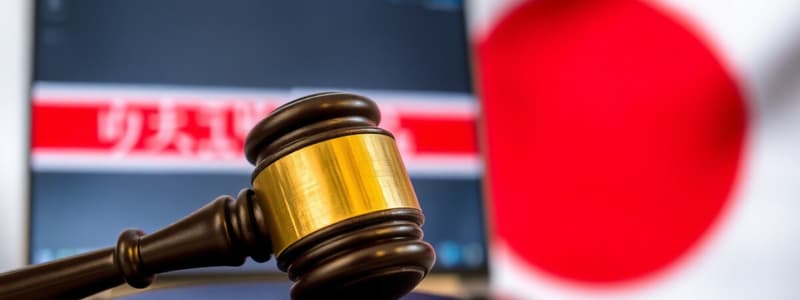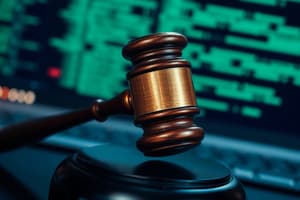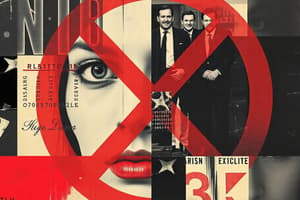Podcast
Questions and Answers
What main issue did the Unlawful Internet Gambling Enforcement Act of 2006 aim to address?
What main issue did the Unlawful Internet Gambling Enforcement Act of 2006 aim to address?
- Regulate online gaming technologies
- Ban online gambling entirely
- Create international gambling laws
- Regulate payment systems used in gambling (correct)
What challenge is highlighted regarding international cooperation in gambling regulation?
What challenge is highlighted regarding international cooperation in gambling regulation?
- Compatibility of different gambling laws
- Absence of unified technology standards
- Lack of consistent enforcement across countries (correct)
- Disagreement over jurisdiction in cases
What tension is discussed in relation to the First Amendment?
What tension is discussed in relation to the First Amendment?
- The conflict between free speech and gambling regulation (correct)
- The need for stricter laws on online advertising
- The impact on international relations
- The balance between freedom and unlawful activity
What is a notable concern regarding technologically-generated images in gambling?
What is a notable concern regarding technologically-generated images in gambling?
What issue remains unresolved regarding child protection in online gambling?
What issue remains unresolved regarding child protection in online gambling?
What is the primary reason mentioned for giving heightened protection to telephone communications and cable TV?
What is the primary reason mentioned for giving heightened protection to telephone communications and cable TV?
Which act aimed to regulate the internet and prevent harassment in electronic media?
Which act aimed to regulate the internet and prevent harassment in electronic media?
What did the court find problematic about censoring entire categories of speech?
What did the court find problematic about censoring entire categories of speech?
Which factor contributed to the unconstitutionality ruling of the Protection of Children Against Sexual Exploitation Act?
Which factor contributed to the unconstitutionality ruling of the Protection of Children Against Sexual Exploitation Act?
What controversial issue arose from the legality of virtual child pornography?
What controversial issue arose from the legality of virtual child pornography?
What was a key conclusion of the Ashcroft v. Free Speech Coalition case?
What was a key conclusion of the Ashcroft v. Free Speech Coalition case?
Which of the following acts specifically criminalized obscene communication to a minor?
Which of the following acts specifically criminalized obscene communication to a minor?
What concern did the court acknowledge regarding children and communication censorship?
What concern did the court acknowledge regarding children and communication censorship?
What is the primary issue regarding the protection of text and images under the First Amendment?
What is the primary issue regarding the protection of text and images under the First Amendment?
How do community standards influence the definition of obscenity?
How do community standards influence the definition of obscenity?
What distinguishes indecent speech from obscene speech?
What distinguishes indecent speech from obscene speech?
Why is it difficult to define obscenity?
Why is it difficult to define obscenity?
What effect does children's accessibility to indecent speech have?
What effect does children's accessibility to indecent speech have?
What is a challenge courts face regarding First Amendment protections?
What is a challenge courts face regarding First Amendment protections?
What can be inferred about virtual images in relation to obscenity?
What can be inferred about virtual images in relation to obscenity?
Which statement best represents the relationship between technology and First Amendment rights?
Which statement best represents the relationship between technology and First Amendment rights?
The First Amendment provides protections against censorship of images found only in physical form.
The First Amendment provides protections against censorship of images found only in physical form.
Community standards play a crucial role in defining what is considered obscene.
Community standards play a crucial role in defining what is considered obscene.
Indecent speech can be broadcasted at any time, regardless of whether children are part of the audience.
Indecent speech can be broadcasted at any time, regardless of whether children are part of the audience.
Obscenity has a clear and universally accepted definition that applies across all communities.
Obscenity has a clear and universally accepted definition that applies across all communities.
Virtual images are treated the same as real images in determining obscenity.
Virtual images are treated the same as real images in determining obscenity.
The First Amendment offers the same level of protection for obscene and indecent speech.
The First Amendment offers the same level of protection for obscene and indecent speech.
The challenge of defining obscenity is exacerbated by the existence of the Internet.
The challenge of defining obscenity is exacerbated by the existence of the Internet.
Technologically-specific criminal legislation usually provides very clear definitions of what is forbidden.
Technologically-specific criminal legislation usually provides very clear definitions of what is forbidden.
The Unlawful Internet Gambling Enforcement Act of 2006 was designed to regulate the payment systems that support internet gambling activities.
The Unlawful Internet Gambling Enforcement Act of 2006 was designed to regulate the payment systems that support internet gambling activities.
The Old Wire Act of 1961 adequately addresses the challenges posed by online sports betting.
The Old Wire Act of 1961 adequately addresses the challenges posed by online sports betting.
International cooperation is sufficient to address the issues of online gambling regulation.
International cooperation is sufficient to address the issues of online gambling regulation.
The First Amendment protects the free flow of information but also raises concerns about the protection of children.
The First Amendment protects the free flow of information but also raises concerns about the protection of children.
Technologically-generated images pose no questions regarding protections and regulations.
Technologically-generated images pose no questions regarding protections and regulations.
Telephone communications and cable TV are considered less accessible than the internet.
Telephone communications and cable TV are considered less accessible than the internet.
The Communications Decency Act of 1996 criminalized only the transmission of obscene materials.
The Communications Decency Act of 1996 criminalized only the transmission of obscene materials.
The Protection of Children Against Sexual Exploitation Act required specific knowledge of a child's age for conviction.
The Protection of Children Against Sexual Exploitation Act required specific knowledge of a child's age for conviction.
The court in Ashcroft v. Free Speech Coalition determined that virtual child pornography could increase danger posed by child molesters.
The court in Ashcroft v. Free Speech Coalition determined that virtual child pornography could increase danger posed by child molesters.
The Telecommunications Reform Act of 1996 aimed to regulate a largely untamed online environment.
The Telecommunications Reform Act of 1996 aimed to regulate a largely untamed online environment.
Censoring entire categories of speech is considered acceptable to protect children.
Censoring entire categories of speech is considered acceptable to protect children.
Virtual child pornography was upheld as a legitimate form of expression by the court.
Virtual child pornography was upheld as a legitimate form of expression by the court.
The lack of a scienter requirement contributed to the ruling of unconstitutionality in the Protection of Children Against Sexual Exploitation Act.
The lack of a scienter requirement contributed to the ruling of unconstitutionality in the Protection of Children Against Sexual Exploitation Act.
Flashcards
First Amendment's protection
First Amendment's protection
Protects freedom of speech, including text and images on computers.
Obscenity definition
Obscenity definition
Difficult to define; community standards vary, especially on the internet.
Community standards
Community standards
Standards of decency vary geographically and with time.
Worldwide community online
Worldwide community online
Signup and view all the flashcards
Virtual vs. real images
Virtual vs. real images
Signup and view all the flashcards
Indecent speech
Indecent speech
Signup and view all the flashcards
Protected speech vs. unprotected speech.
Protected speech vs. unprotected speech.
Signup and view all the flashcards
Broadcasting limitations
Broadcasting limitations
Signup and view all the flashcards
CDA (Communications Decency Act)
CDA (Communications Decency Act)
Signup and view all the flashcards
Protection of Children Against Sexual Exploitation Act (1977)
Protection of Children Against Sexual Exploitation Act (1977)
Signup and view all the flashcards
Scienter
Scienter
Signup and view all the flashcards
Virtual child pornography
Virtual child pornography
Signup and view all the flashcards
Ashcroft v. Free Speech Coalition
Ashcroft v. Free Speech Coalition
Signup and view all the flashcards
Traditional notions of decency
Traditional notions of decency
Signup and view all the flashcards
Obscene Communication
Obscene Communication
Signup and view all the flashcards
Compelling governmental interest
Compelling governmental interest
Signup and view all the flashcards
UIGEA's Purpose
UIGEA's Purpose
Signup and view all the flashcards
Old Wire Act's Limitation
Old Wire Act's Limitation
Signup and view all the flashcards
International Cooperation in Cybercrime
International Cooperation in Cybercrime
Signup and view all the flashcards
Free Flow of Info vs. Child Protection
Free Flow of Info vs. Child Protection
Signup and view all the flashcards
WTO's Role in Internet Crime
WTO's Role in Internet Crime
Signup and view all the flashcards
First Amendment & Computer Crime
First Amendment & Computer Crime
Signup and view all the flashcards
Obscenity: A Fuzzy Concept
Obscenity: A Fuzzy Concept
Signup and view all the flashcards
Indecent vs. Obscene Speech
Indecent vs. Obscene Speech
Signup and view all the flashcards
Internet Gambling: A Legal Minefield
Internet Gambling: A Legal Minefield
Signup and view all the flashcards
Free Flow of Information vs. Child Protection
Free Flow of Information vs. Child Protection
Signup and view all the flashcards
What is the CDA?
What is the CDA?
Signup and view all the flashcards
What was the Protection of Children Against Sexual Exploitation Act?
What was the Protection of Children Against Sexual Exploitation Act?
Signup and view all the flashcards
Obscene communication: Minors
Obscene communication: Minors
Signup and view all the flashcards
UIGEA's Goal
UIGEA's Goal
Signup and view all the flashcards
Old Wire Act's Weakness
Old Wire Act's Weakness
Signup and view all the flashcards
First Amendment vs. Child Protection
First Amendment vs. Child Protection
Signup and view all the flashcards
International Cooperation: The Cybercrime Challenge
International Cooperation: The Cybercrime Challenge
Signup and view all the flashcards
WTO's Role in Cybercrime
WTO's Role in Cybercrime
Signup and view all the flashcards
Study Notes
Computer Forensics and Cyber Crime - Applying the First Amendment
- Protections against censorship of text and images are guaranteed by the First Amendment's right to free speech.
- Court rulings on the protection of material vary.
- Technology-specific laws often use vague definitions of forbidden content, encompassing emerging technologies.
- Defining obscenity is difficult; often described as "I know it when I see it."
- Community standards vary on what is considered obscene.
- The existence of a global internet community complicates the determination of obscenity, as virtual and real images can differ.
Traditional Notions of Decency
- Speech can be indecent without being obscene.
- Indecent speech is restricted when children are likely within the audience (e.g., radio, TV).
- Telephone and cable TV communications have stronger protections as they do not reach captive audiences in the same way.
- While protecting children is important, censoring entire categories of speech is not acceptable.
Emerging Statutes and Child Pornography
- The Communications Decency Act (CDA) of 1996 aimed to regulate cyberspace, criminalizing harassment, stalking, and obscene communication to minors. Also criminalized the sending of information that is "prima facie offensive".
- The Protection of Children Against Sexual Exploitation Act of 1977 didn't require proof of the perpetrator's knowledge of a child's age which led to a ruling of unconstitutionality.
Technology-Specific Legislation - Content in the Courts
- The legality of virtual child pornography and its impact on child molesters was questioned in Ashcroft v. Free Speech Coalition case.
- The court ruled against the argument that virtual child pornography increased the danger of child molesters.
Internet Gambling
- The Old Wire Act of 1961 was deemed insufficient to address the rise of online sports betting and bookmaking activities.
- The Unlawful Internet Gambling Enforcement Act (UIGEA) of 2006 attempted to regulate payment systems for online gambling.
Future Issues and Conclusions
- Conflicts exist between protecting freedom of information and protecting children.
- The specifics of protecting content generated or altered by technology is still uncertain .
Studying That Suits You
Use AI to generate personalized quizzes and flashcards to suit your learning preferences.
Related Documents
Description
Test your understanding of the First Amendment's impact on computer forensics and cyber crime. This quiz covers the complexities of censorship, obscenity definitions, and community standards in the context of emerging technologies. Explore how traditional notions of decency influence legal interpretations.




